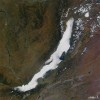Echo
Cougar verified in Wisconsin
|
Another cougar was photographed by a trail camera earlier this month in the Great Lakes region – this time in Juneau County, Wisc. Wisconsin Department of Natural Resources biologists confirmed the presence of four cougars over the last three years, and seven trail cameras have documented cougar activity in the state according to a press release from the Department. Biologists believe most of these cougars are from South Dakota, making their way through Wisconsin to find territory and mates. Who knows, maybe they’ll end up in the Upper Peninsula.








